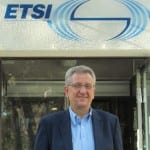Technology continues to deliver wonders but can be a victim of its own success. Advances that were once considered impossible are achieved frequently and, it would seem to many outside observers, with apparent ease.
December 19, 2016

From time to time, Telecoms.com invites industry leaders to comment on the industry’s latest challenges, opportunities and advancements in technology. In this exclusive piece, the Chairman of the NFV ISG at ETSI, Diego López, gives us an update on network functions virtualization, and ponders the future of the technology.
Technology continues to deliver wonders but can be a victim of its own success. Advances that were once considered impossible are achieved frequently and, it would seem to many outside observers, with apparent ease. As a result, there is a certain impatience and sense of anti-climax when revolutionary change fails to materialise each time we look for it. This year’s mobile handsets are impressive devices but, judged against their preceding generations, may not deliver a quantum leap in user experience.
The phenomenon is not limited to consumer expectations. The market analyst company Gartner produces an annual assessment of what it terms the Emerging Technology Hype Cycle where it provides its assessment of the progression from wide-eyed optimism, through disillusionment, to widespread adoption of new technologies. In its latest incarnation, this curve features Software-Defined Anything (SDx) as being on the point of tumbling from the ‘Peak of inflated expectations’ into the ‘Trough of disillusionment’. This view no doubt reflects the opinions of some other industry observers who believe that the move to virtualised systems is proving too slow.
Another software-based technology, Network Functions Virtualisation (NFV), has received similar criticism recently with some suggesting that progress has not been quick enough. But this is at best harsh and at worst untrue. Let’s look at the facts.
Since ETSI created the NFV Industry Specification Group (ISG) in November 2012, the membership has grown from a small number of influential founders to around 300 organisations. More than 40 documents have been published in that time. The NFV Release 2 specifications have recently been announced and work is well advanced on Release 3. In parallel with this, companies are preparing to roll out commercial NFV-based services; Telefonica has recently deployed NFV-based services in Brazil and is involved in several pre-commercial service deployments in other countries within its footprint. Furthermore, to encourage and assist participation, a wide range of NFV Proofs of Concept have been developed.
It is true that different implementations are under development, as collaborative or as proprietary initiatives, but this diversity is to be welcomed. Part of the skill of a body such as ETSI is the ability to identify best of breed solutions and ensure that the relevant elements are incorporated into emerging standards, fusing the experience and expertise of members to form a platform from which everyone can reap rewards going forward.
The open source software communities follow a similar pattern and are actively engaged in the NFV debate. Open source projects absorb ideas from a community of contributors of various sizes and weave them into a stable, usable, functional whole from which all can benefit. Standards bodies fulfil a similar function drawing from their members and, in the case of NFV, from open source software groups also. Indeed, ETSI hosts a project to develop an open source NFV Management and Orchestration (MANO) software stack.
The goal of the ETSI NFV ISG has been to create a strong, sustainable specification that is flexible enough to accommodate and adjust to both current demands and emerging requirements that are so far unknown. It will enable network functions to be deployed dynamically and on-demand, making organisations more agile. Looking from this perspective, NFV is making good progress and is very much on track. January 2017 sees the staging of the first NFV PlugtestsTM event where equipment vendors and open source software projects will be able to assess the interoperability of their implementations and verify the correct interpretation of the ETSI NFV specifications.
NFV promises to deliver significant benefits to service users and providers alike, with the emerging 5G technology being the paradigmatic case. The speed of NFV’s adoption will be dependent on the prevailing business case as much as the achievement of technological milestones. Clear financial benefits must be weighed up against the costs of early replacement of existing hardware that may have many years operational life left. There will also need to be a cultural shift within companies where recruitment and training must reflect the move from hardware to software. Because of this, traditional physical functionality is likely to co-exist with virtualised functionality for a number of years. However, what can be said is that the framework to achieve NFV’s goals is well established and the participants are making good progress on the route to an effective solution.
 Diego Lopez joined Telefónica I+D in 2011 as a Senior Technology Expert on network middleware and services. He is currently in charge of the Technology Exploration activities within the GCTO Unit of Telefónica I+D. Before joining Telefónica, he spent some years in the academic sector, dedicated to research on network service abstractions and the development of APIs based on them. During this period he was appointed as a member of the High Level Expert Group on Scientific Data Infrastructures by the European Commission.
Diego Lopez joined Telefónica I+D in 2011 as a Senior Technology Expert on network middleware and services. He is currently in charge of the Technology Exploration activities within the GCTO Unit of Telefónica I+D. Before joining Telefónica, he spent some years in the academic sector, dedicated to research on network service abstractions and the development of APIs based on them. During this period he was appointed as a member of the High Level Expert Group on Scientific Data Infrastructures by the European Commission.
Diego is currently focused on identifying and evaluating new opportunities in technologies applicable to network infrastructures, and the coordination of national and international collaboration activities. His current interests are related to network virtualization, infrastructural services, network management, new network architectures, and network security. Diego chairs the ETSI Industry Specification Group (ISG) on Network Functions Virtualization (NFV) and is co-chair of the NFVRG within the IRTF.
Read more about:
DiscussionAbout the Author(s)
You May Also Like








.png?width=300&auto=webp&quality=80&disable=upscale)


_1.jpg?width=300&auto=webp&quality=80&disable=upscale)


.png?width=800&auto=webp&quality=80&disable=upscale)